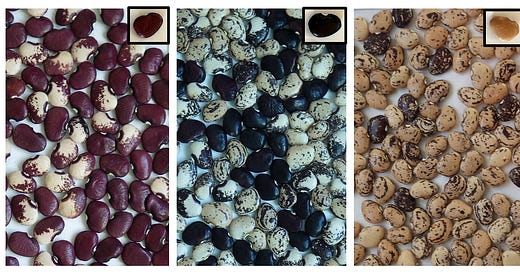Time for another mini-post, this time about butterbeans.
For over a hundred years, my family has handed down and grown what we’ve always called colored butterbeans. My great-grandma brought them with her when her family moved from Belhaven, N.C. to Roanoke Rapids in about 1915; where they came from before that I haven’t a clue. They’re unique, as they have about eight different color patterns. I’ve never seen them in any of the seed catalogs, wherein beans of a given variety all look exactly alike.
By contrast, our butterbeans feature four different colors: off-white, tan, violet, and deep purple; and four basic patterns: solid color, pocket patch, mottled, and tri-colored. With some mixing, as you’ll see.
So maybe 10 years ago I decided to plant in separate spots a hill of each of the seven patterns I had at that time. The idea was to see how they were inherited when grown out. In the pics below, the color pattern that was planted is indicated by the inset at the upper right, and the adjacent beans illustrate the spread of the colors and patterns that manifested.
They reveal some crossover, verifying what we’ve always assumed: that despite the different color patterns, they’re all just one variety of heirloom bean. Nevertheless, violet never mixes with deep purple in any pattern, and at least in this test, the violet and deep purple pocket-patch patterns (tongue-twister there) bred true. Surprisingly, in 2024 a pattern showed up that I’d never seen before: the tri-color of tan, off-white, and a sprinkle of deep purple, variously arranged according to the pocket-patch mosaic.
Whether fresh, canned, frozen, or dried, they certainly all turn out the same within a given type of preservation and cooking, and their size and shape are uniform. The taste is savory-buttery and the texture is sooo tongue-friendly smooth—absolutely delicious. Plus, the color splashes are stunning. Can’t beat it with a stick, as the old folks in Roanoke Rapids used to say.






